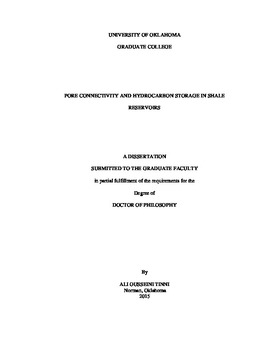| dc.contributor.advisor | Sondergeld, Carl | |
| dc.contributor.author | Ousseini Tinni, Ali | |
| dc.date.accessioned | 2015-12-15T15:58:20Z | |
| dc.date.available | 2015-12-15T15:58:20Z | |
| dc.date.issued | 2015-12 | |
| dc.identifier.uri | https://hdl.handle.net/11244/23297 | |
| dc.description.abstract | Considerable advances have been made in the science of shale characterization during the past two decades. However, the evaluation of the production potential of shale reservoirs is still hindered by the lack of understanding of fluid flow and storage. The present dissertation summarized several laboratory experiments designed to evaluate pore connectivity as well as storage and production mechanisms in shale reservoirs.
SEM studies on ion milled surfaces of shales revealed that the pores in shales have sub micrometer diameters and are associated with the organic matter, the inorganic minerals and the interfaces between organic matter and inorganic minerals. The organic pores are hydrocarbon wet, while the inorganic pores are generally water wet and the pores at the interfaces between organic matter and inorganic minerals are considered mix wet. The Current methods used to study pore connectivity fail to acknowledge the presence of pores with different wettability. The storage and flow of fluids as a function of pore wettability invalidates the concept of oil-water relative permeability in shales.
The combination of spontaneous imbibition and pressure saturation of shale samples with brine and dodecane was used to study the connectivity of the water wet and hydrocarbon wet pore network. 20 wt% of clay and 3-4 wt% of TOC are required to develop a connected water wet and hydrocarbon wet pore network respectively. The connectivity of the water wet and hydrocarbon wet pore networks are enhanced by the presence of mix wettability pores. These mixed wettability pores provide the best flow path for hydrocarbon delivery.
The study of the hydrocarbon storage mechanisms in shales was conducted by measuring the NMR T2 spectra of shale samples saturated with methane and ethane at different pore pressures. Storage measurements show that the main mechanism of fluid storage at high pressures is fluid compressibility while adsorption and capillary condensation are the main storage mechanisms at low pressures. In contrast with numerous model predictions, no change in fluid critical properties was observed.
The multicomponent desorption experiments show that heavier hydrocarbons can be preferentially adsorbed during the production of hydrocarbon. This preferential adsorption will induce a dynamic change in the in-situ fluid composition during pressure depletion. | en_US |
| dc.language | en_US | en_US |
| dc.subject | Shale | en_US |
| dc.subject | pore connectivity | en_US |
| dc.subject | hydrocarbon storage | en_US |
| dc.subject | adsorption | en_US |
| dc.title | PORE CONNECTIVITY AND HYDROCARBON STORAGE IN SHALE RESERVOIRS | en_US |
| dc.contributor.committeeMember | Rai, Chandra | |
| dc.contributor.committeeMember | Devegowda, Deepak | |
| dc.contributor.committeeMember | Callard, Jeffrey | |
| dc.contributor.committeeMember | Resasco, Daniel | |
| dc.date.manuscript | 2015-12-14 | |
| dc.thesis.degree | Ph.D. | en_US |
| ou.group | Mewbourne College of Earth and Energy | en_US |
| shareok.nativefileaccess | restricted | en_US |
